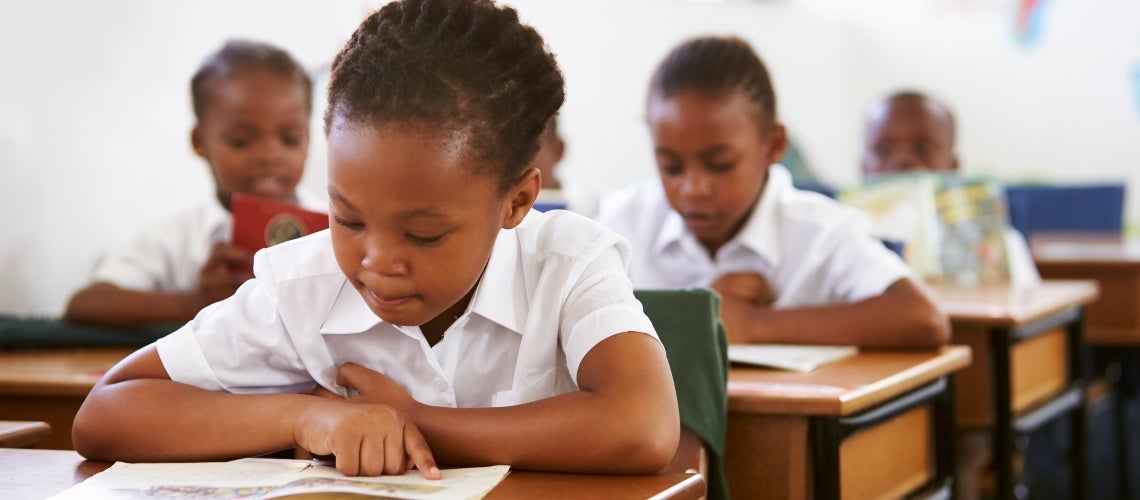 Quality instruction in the classroom and practicing reading at home can help ensure that children grow up as readers and learners. Copyright: Shutterstock
Quality instruction in the classroom and practicing reading at home can help ensure that children grow up as readers and learners. Copyright: Shutterstock
On this International Literacy Day, let us remember that an unacceptable number of children do not know how to read. Seventy percent of children in low- and low-middle income countries are unable to read and understand a simple paragraph by the age of 10 (which we call learning poverty). This learning crisis squanders young peoples’ potential, negatively impacts the workforce of the future, and erodes the economic competitiveness of countries.
However, getting every child reading is within our reach. So, how do we make every child literate?
- Children need more effective literacy instruction in school.
Decades of research have identified the mechanisms to get children reading. In schools, teachers need to teach the right things at the right time. This involves having a sound and clear phonics-based curricula, teacher and learning materials which are aligned with the curriculum, professional development that empowers teachers to make use of curricula and materials, adequate instructional time, and languages of instruction that children know. Countries must follow the science of reading to make rapid improvement at scale. The World Bank’s Literacy Policy Package and Early Grade Reading Rainbow are among the many resources that support literacy for all.
- Children need to practice reading in their homes and communities.
While quality instruction is critical to teach children to read, it isn’t enough. The process of learning to read starts at home, long before children reach primary school age, and continues at home as children grow. Children’s experiences of speech begin at birth and have a profound impact on their development, school readiness, and how well they do at school. Unfortunately, far too many children are growing up without the rich speech and print interactions needed to arrive at school ready to read and ready to learn. Just 2% of children under the age of five in sub-Saharan Africa are growing up with three or more children’s books in their homes.
Even when children are in school, they need plenty of practice and exposure to diverse books to become independent readers. Since children spend significantly more time at home than at school, time at home needs to complement and strengthen their learning in school. Reading at home is not a “nice to have” or an “add-on”; it’s an important investment to ensure enough exposure and practice for children to become readers.
We must make learning possible everywhere, especially in the most vulnerable and hard-to-reach households. The Read@Home initiative was created to address these challenges. Read@Home is working with 17 countries so far to expand access to quality reading books, reduce the cost of procuring and distributing books, and help parents and caregivers support their children’s learning. In Senegal, for example, Read@Home is supporting the government to improve the continuum of support between early learning, schools, homes and communities. The government will provide quality reading materials and support to caregivers to read at home to over 2 million children aged zero to six (50% of all children below the age of six) in seven out of 14 regions with the lowest early childhood development outcomes in the country.
- Enabling reading—both at school and at home—requires procuring and distributing books efficiently, affordably, and sustainably.
Making books available to all children is essential if we are to end learning poverty. However, inefficient book procurement processes in countries are resulting in fewer, lower-quality, higher cost books being distributed to children, if they arrive at all. Recent analysis by USAID for example, finds the average costs of procuring reading books for children ranges from $0.08 per book in South Asia to $0.86 per book in West Africa. These are average costs—some books in West Africa cost as much as $23 each! One straightforward way to compare book prices is to compare costs per 1,000 square meters of paper ordered. In a forthcoming study, we found prices for the same type of paper in a single country in a single year that ranged from $316 per 1,000 square meters to $1,095. In a nearby country, higher quality paper also procured through a World Bank project cost $155 per 1,000 square meters.
We need to invest in systems and processes that enable countries to purchase and deliver books efficiently, affordably, and sustainably. Governments can adopt fast and practical strategies to make good use of scarce resources, including:
- Open-source resources such as the Early Learning Resource Network (ELRN) to find quality books and educational materials which can be adapted to country contexts. Along with providing print-ready open source books, the ELRN includes a cost calculator to estimate printing costs for different types of books and a set of caregiver engagement packages containing practical, readily adaptable materials.
- Procurement approaches(such as following standard technical specifications) which are proven to reduce the cost of books at scale (see the Mozambique example for a case in point).
- Distribution management systems like track-and-trace to track books from the printer to schools and ensure they arrive at their intended destinations on time (see the Cambodia example for more details).
Learning poverty should not be a life sentence. We can and must take action to ensure all children grow up as readers and learners. And what better day to start to take action than today, on International Literacy Day?


Join the Conversation